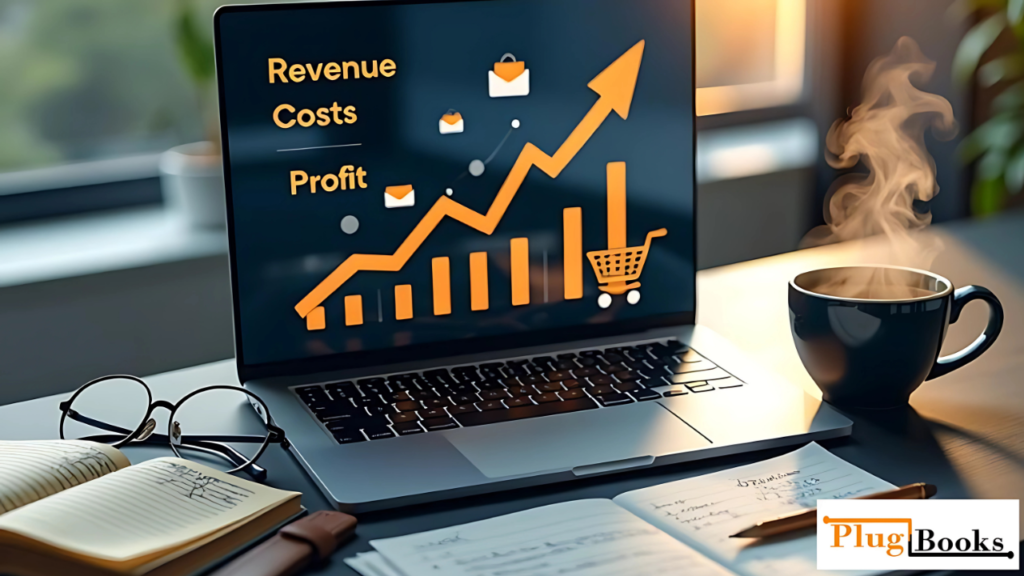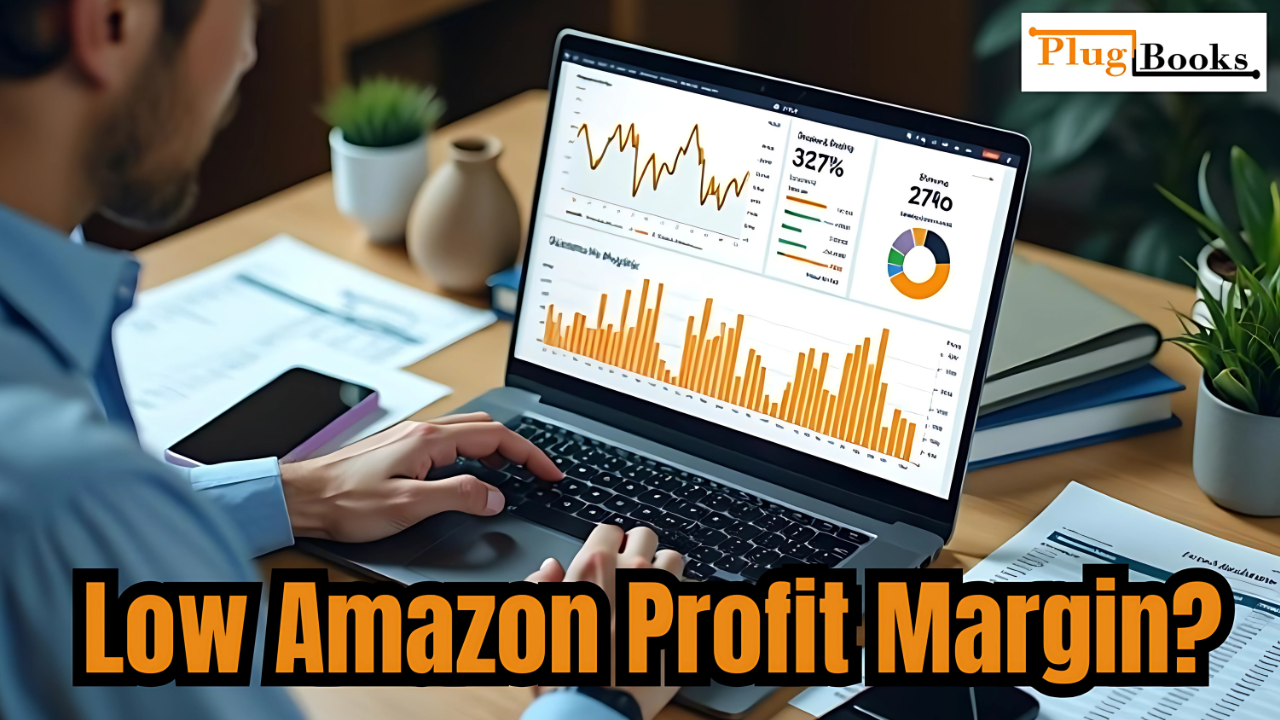Knowing that you will be selling items on Amazon will help you to understand its profit margin among other things. Whether you have been selling for a long time or just now, you must know your income after all expenses if you wish to manage a profitable company. But what is Amazon’s profit margin, and why does it matter?
We’ll define Amazon profit margin, review the factors influencing it, and walk you through how to compute it on this blog. Tools like Plugbooks can help automate this process by tracking your fees, costs, and sales in real time. Knowing your Amazon profit margin will help you decide on your price and, ultimately, increase your income. Let’s discuss all you require to know about the platform to ensure your company performs as expected there.
Keynotes
- The Amazon profit margin is the amount of money the company makes after paying for things.
- Amazon’s earnings margins are affected by seller fees and the cost of goods sold.
- Sellers on Amazon can make anywhere from 10% to 30% in profit.
- Track your Amazon’s profit margin on a regular basis to make your business run better.
- Plugbooks works with QuickBooks, which makes it easier to keep track of and handle Amazon’s profit margins.
What is Amazon’s Profit Margin?
Following expenses like manufacturing, shipping, marketing, and fulfilment fees, Amazon’s profit margin reveals the remaining profit margin. Profit margins of Amazon sellers depend on several factors including the kind of goods, degree of competition, and running performance of the company.
Amazon depends on numbers and scale to generate a lot of money, hence as a marketplace it has rather poor profit margins. Based on the kind of goods and how the seller runs their business, Amazon’s profit margins can range from 10% to 30% for individual sellers, though.
For instance, typically speaking, selling gadgets has smaller profit margins than selling books or hand-made items. If you’re trying to figure out Amazon’s profit margin for your specific business, understanding your product costs and fees is the first step.

How to Calculate Your Amazon Profit Margin
Your Amazon’s profit margin is simple to calculate, but you should monitor a few important indicators as well. Sales margins for vendors on Amazon can be calculated quickly here:
- Total Revenue: The whole sum of money you get from selling your products is your revenue.
- Amazon Fees: Examples of Amazon fees include referral fees, Fulfilled by Amazon (FBA) fees, and other sale costs like closing fees.
- Cost of Goods Sold (COGS): The whole amount you paid for purchasing or manufacturing your items is known as your cost of goods sold (COGs).
- Shipping Costs: For FBA sellers, this includes forwarding costs to Amazon’s fulfillment facilities. It covers direct shipping expenses for FBM vendors.
Formula
Profit Margin=Revenue−COGS−Amazon Fees−Shipping CostsRevenue×100\text{Profit Margin} = \frac{\text{Revenue} – \text{COGS} – \text{Amazon Fees} – \text{Shipping Costs}}{\text{Revenue}} \times 100
This formula will give you the percentage of profit you make after all expenses are deducted. For instance, if your total revenue is $100, your COGS is $30, Amazon fees are $15, and shipping costs are $10, your Amazon’s profit margin would be:
100−30−15−10100×100=45%\frac{100 – 30 – 15 – 10}{100} \times 100 = 45\%
Factors That Affect Amazon Profit Margins
Several factors influence Amazon’s profit margins for both Amazon as a company and individual sellers. By understanding these factors, you can better plan your business strategy. Some of the key factors include:
1. Amazon Seller Fees
Amazon charges varying fees based on your preferred selling strategy. For FBA purchasers, some of these costs include transaction fees, listing fees, storage and fulfillment fees.
2. Cost of Goods Sold (COGS)
The price you purchase or produce the goods determines your profit. You could make more money the more reduced your COGS are.
3. Shipping and Fulfillment
Although using FBA costs extra, there are several advantages including being able to speak with Amazon’s customer support and having your things dispatched faster. For FBM vendors, shipping costs must be included into their profit margin.
4. Advertising Costs
Many Amazon sellers utilize the advertising options on the website to spread the news about their products, therefore paying expenses of advertising. While determining Amazon’s profit margins, one should consider the expense of advertising since they might significantly reduce income.
5. Competition
The degree of competitiveness in your product line determines your possible price for it. Should there be a lot of competition, you could have to cut your prices and forfeit some of your profit margin.
How Do You Improve Your Amazon Profit Margin?
Maximizing your Amazon’s profit margin requires a strategic approach. Here are some effective ways to improve your profitability:
1. Negotiate with Suppliers
Your profit margin can be much improved by lowering the cost of your goods. Discuss with your vendors obtaining better rates or discounts for mass purchases.
2. Use Amazon’s FBA Wisely
Though it can be costly, it saves time and improves the client experience. See whether the simplicity of FBA use justifies the expenses for your company.
3. Optimize Pricing
Pricing is a difficult matter to get perfect. Should you cut your prices excessively, you might lose money on Amazon; yet, should you set them too high, you could lose business. Constant demand and market observation will help you to adjust your prices as necessary.
4. Reduce Advertising Costs
Instead of spending money on broad efforts, concentrate on ads that are very specific and get good results. Keep an eye on your ads’ return on investment (ROI) to make sure you’re not spending too much.
5. Streamline Operations
Using inventory management tools will help you cut down on wasteful business practices like having too much or too little stock. This keeps you from having to pay extra for shipping or storage.
If you use these tips, you can increase your Amazon’s profit margin and make your business more successful.

What is Amazon’s Profit Margin for Sellers?
Amazon may not have a very high average profit margin compared to other companies, but sellers can make a lot of money on Amazon. Amazon profit rates for most sellers are between 10% and 30%, but this can change based on the type of product, fees, and selling strategy.
For example, private-label sellers often have higher profit margins than retailers because they have more control over how much it costs to make the goods. On the other hand, because of Amazon fees and the cost of getting the products, middlemen who sell third-party goods often have smaller profit margins.
How Plugbooks Helps with Managing Amazon Profit Margins
If you sell things on Amazon, it can be hard to keep track of your Amazon’s profit margins and other costs. Now this is where Plugbooks come in. Plugbooks works perfectly with QuickBooks to give you a full picture of your sales, fees, costs, and earnings. When you sync your Amazon sales data with QuickBooks, QuickBooks will automatically figure out your Amazon profit margin, keep track of your costs, and make your accounting tasks easier.
This integration streamlines bookkeeping, which makes it easier to keep an eye on your profits and make choices based on data to boost your margins. You can spend more time growing your business and less time handling complicated financial data when you use Plugbooks.io.
Final Thoughts
If you want to run a successful Amazon business, you need to know how to figure out Amazon’s profit margin and understand the things that affect it. You can make your Amazon business more profitable and grow it by figuring out your margin and improving the things that affect it, like price, advertising, and how well your business runs.
Remember that Amazon’s profit margins are very different based on your products and business model, so keep an eye on your strategy and make changes as needed.
Disclaimer
This blog gives basic information on how to understand and figure out Amazon’s profit margin. Always talk to a financial expert or accountant for personalized help and to make sure that your financial reports are correct.




